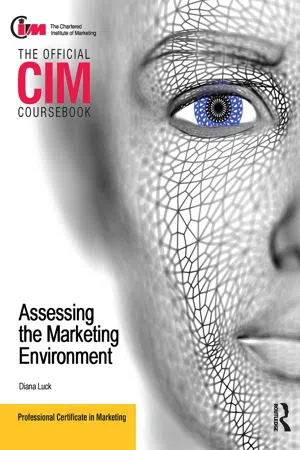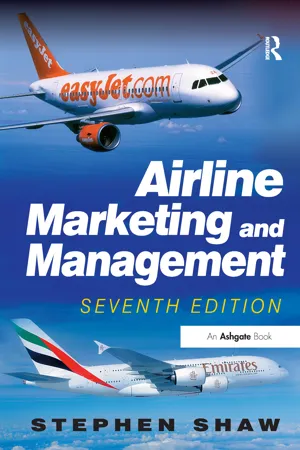Marketing
Marketing Environment
The marketing environment refers to the external factors and forces that affect a company's ability to develop and maintain successful customer relationships. It includes elements such as economic, technological, political, cultural, and competitive factors. Understanding the marketing environment is crucial for businesses to adapt their strategies and tactics to effectively reach and satisfy their target market.
Written by Perlego with AI-assistance
8 Key excerpts on "Marketing Environment"
Learn about this page
Index pages curate the most relevant extracts from our library of academic textbooks. They’ve been created using an in-house natural language model (NLM), each adding context and meaning to key research topics.
- eBook - ePub
- Mo Willan(Author)
- 2021(Publication Date)
- Bloomsbury Business(Publisher)
CHAPTER THREE The Marketing EnvironmentAnalysing and understanding the Marketing Environment is an important prerequisite for identifying customer needs and wants and a successful marketing practice. Organizations exist and operate in complex and ever-changing environments, and these changes can either present opportunities for the organization to exploit or pose a threat to the success or survival of the organization. Such environments can be local, national or even global.There are many players and actors in the environment, and these include suppliers, intermediaries, customers, competitors, governments and other stakeholders. Thus, the Marketing Environment can be defined as consisting of many forces and actors that are predominantly outside marketing but which can affect the organization’s ability to develop and maintain mutually beneficial relationships with its targeted customers.‘Environmental scanning’ is a process undertaken to identify, monitor, analyse and respond to the forces in the firm’s environment which can affect its performances. It involves: • Monitoring the trends, key events and pertinent issues that can affect the firm • Identifying the factors that can significantly impact the firm’s operations • Evaluating or assessing the impact of these factors on the company • Forecasting likely scenarios to determine both opportunities and threatsEnvironmental scanning therefore implies that firms should consistently gather information on the issues and events happening around them to respond appropriately. Such information gathering exercises are critical to the firm’s ongoing planning processes and also serve as a basis for determining likely opportunities and threats facing the firm. - eBook - ePub
- Sally Dibb, Lyndon Simkin(Authors)
- 2007(Publication Date)
- Routledge(Publisher)
4: The Marketing Environment
Key definitionsThe Marketing Environment is defined as the external forces that directly or indirectly influence an organization's capability to undertake its business.The macro Marketing Environment consists of six core forces: political, legal, regulatory, societal/green, technological, plus economic/competitive issues.The micro Marketing Environment includes more company-specific forces: types of competition, supplier power, buyer power, and a business's other publics.Environmental scanning is the process of collecting information about the forces of the Marketing Environment.A strategic window is a major development or opportunity triggered by change in the Marketing Environment.Key issuesThe Marketing Environment consists of trading forces operating in a marketplace over which a business has no direct control, but these forces will shape the manner in which the business functions and is able to satisfy its customers.Owing to the ‘beyond direct control’ aspect, too many organizations fail to adequately monitor the key forces of their Marketing Environment. Those businesses that do assess evolving trends and the implications from environmental change, tend (a) not to encounter as many market-driven crises, and (b) often gain a competitive advantage over rivals that have failed to understand the implications from a particular environmental occurrence.The macro Marketing Environment forces are the ‘big’ issues that affect all businesses active in a particular market and indeed all customers in a target market segment. While individual businesses or customers may well be better placed to accommodate such issues and their implications, these forces do affect everyone in a market.The macro forces were first identified by economists in a PEST analysis (cf. Brief 5 - eBook - ePub
- Richard M.S. Wilson(Author)
- 2010(Publication Date)
- Routledge(Publisher)
The Marketing Environment has been defined in a variety of ways. One view, for example, has referred to it in terms of factors that are outside the system’s control but which determine, in part at least, how the system performs. For our purposes, however, the definition that we will work with is that an organization’s Marketing Environment is made up of those forces that lie outside the organization and which exert some degree of influence upon the ways in which marketing management develops relationship with the firm’s target markets.Within the environment there are two distinct components: the microenvironment and the macro-environment. These are illustrated in Figure 5.6 .Figure 5.6 The organization's Marketing EnvironmentThe micro-environment is made up of those elements that are closest to the company and that exert the greatest and most direct influence over its ability to deal with its markets. This includes the organization itself, its suppliers, its distribution network, customers, competitors and the public at large. The macro-environment consists of the rather broader set of forces that have a bearing upon the company, including economic, demographic, technological, political, legal, social and cultural factors. Together, these elements of the environment combine to form what we can loosely refer to as the non-controllable elements of marketing, which in many ways act as a series of constraints on the parameters within which the marketing planner is required to operate.In labelling these elements as non-controllable, the reader should recognize that, in some cases at least, the marketing planner may well adopt a highly proactive stance in an attempt to alter the nature and impact of the environment upon the organization – for example, by attempting a merger or takeover in order to minimize a competitive threat. Equally, a large organization may well lobby the government in order to have legislation developed or changed so that the company benefits in some way. The car, foodstuffs, defence cigarette and brewing industries, for example, all have powerful lobby groups that attempt to exert a degree of influence over government to ensure that any legislation is beneficial (or at least not harmful) to their interests. In other cases, however, the organization may adopt a rather more reactive stance and simply view the environment as something that has to be lived with and responded to. - eBook - ePub
- Paul Reynolds, Geoff Lancaste(Authors)
- 2013(Publication Date)
- Routledge(Publisher)
In the previous chapter we discussed the importance of the customer as the essence of the business philosophy we call ‘marketing’. Although a clear understanding of customer requirements is of paramount importance in putting such a business philosophy into practice, this alone is not enough. Firms must monitor not only the changing needs and wants of target markets, but also changes in the wider, external or ‘macro’ environment. This is necessary if the organisation is to be able to prepare to adapt to changing conditions.3.2 Monitoring the external environment3.2.1 Capitalising on environmental changeWith environmental change organisations should, if possible, capitalise on it rather than merely react to it in a purely defensive manner. Firms can very rarely control their macro-environment, but they can understand and, to a certain extent, anticipate it.Key pointFirms can very rarely control their macro-environment, but they can understand and, to a certain extent, anticipate it.The ability of companies to understand and react to environmental forces is of vital importance to marketing success. In fact an individual organisation’s new technology may be the external environmental force of technology that is affecting other organisations! Zeithaml and Zeithaml (1984) give examples of environmental management strategies that firms can use to influence the largely uncontrollable environment.The general Marketing Environment is made up of all factors and forces that affect or influence the marketing function. These include interdepartmental relationships (referred to here as the intra-firm environment) and all other external factors (the macro-environment).The macro-environment can, in turn, be broken down into two broad categories:DefinitionThe general Marketing Environment is made up of all factors and forces that affect or influence the marketing function.1 The marketing company’s immediate environment is the marketing function itself, consisting of the ‘Four Ps’ plus an extra People ‘P’, the latter being those who are there to ensure the smooth operation of the marketing function. This leads to the ‘intra-firm’ environment, consisting of other departments in the company such as finance, production, human resource management, and research, design and development. The next layer is called the ‘micro-environment’, and this consists of suppliers, customers, competitors, distributors and marketing intermediaries like advertising agencies and marketing research companies. - eBook - ePub
Entrepreneurship Marketing
Principles and Practice of SME Marketing
- Sonny Nwankwo, Ayantunji Gbadamosi, Sonny Nwankwo, Ayantunji Gbadamosi(Authors)
- 2020(Publication Date)
- Routledge(Publisher)
Chapter 4The entrepreneurship Marketing Environment
Ayantunji GbadamosiLEARNING OBJECTIVESAfter reading this chapter, you will be able to:Understand the meaning of Marketing Environment;Discuss the nature of the SMEs Marketing Environment;Differentiate between the external and internal Marketing Environment of SMEs;Understand the impact of Macro- and Microenvironmental factors on the marketing activities of SMEs;Explain environmental scanning and why it is important in SME marketing;Discuss the relevance of SWOT analysis to SME marketing;Understand how SMEs cope with the turbulence in the Marketing Environment.INTRODUCTIONNo business exists in a vacuum. Irrespective of the size and scale of their operations, business organisations operate within environments which either directly or indirectly influence how they plan, organise, and execute their marketing activities. Similarly, regardless of whether they are small and medium scale enterprises (SMEs) or large corporations, these environments contain certain factors and forces that combine to impinge on how they relate to their customers. Therefore, it is logical to state that having an in-depth understanding of the Marketing Environment is very fundamental to the study of SME marketing. Now, let us first consider a working definition of Marketing Environment that will guide our discussion in this chapter. We may simply define Marketing Environment as the totality of factors and actors that both presently influence or in the future might influence how marketers go about satisfying the needs and wants of their target market.From this definition, we can deduce that organisations interact with the various elements of the environment and the extent to which they are able to do this effectively is significantly determined by the characteristic of the organisation involved. This is where the distinction between the context of SMEs and large corporations can be appreciated. Although, there is a clear lack of consensus on what constitutes the definition of SMEs as they vary with sectors, and most importantly across different countries of the world, there is agreement that they are smaller in many ramifications when compared to their large corporation counterparts. This suggests that the impact of the environmental factors on these organisations, and the way they also respond to them might be dissimilar, hence our need to look into Marketing Environment in the context of SMEs. - Diana Luck(Author)
- 2010(Publication Date)
- Routledge(Publisher)
CHAPTER 2The External Environment and Stakeholders
Learning Outcomes
Scope and complexity of the Marketing Environment.The significance of shareholders and various stakeholders to the marketing process.Classification of external challenges and influences.STUDY TIPThis chapter introduces the Marketing Environment, considers the nature and importance of environmental change and identifies some implications for marketing strategy and planning. The micro-environment may be defined as including the groups and organisations that have a two-way operational relationship with the business, and which are controlled and influenced by it to some degree. This environment is the work-a-day operational context for the organisation. We saw in Chapter 1 that the organisation is an open system with boundaries to its immediate environment. Relationships must be established across these boundaries if supplies or credit, for example, are to be obtained. Similarly, the organisation must have effective linkages, through intermediaries, to the marketplace, or directly to the final customers themselves. Competitors also inhabit this environment and the marketer must understand the significance of relationships that prevail within the industry setting. This will be discussed in depth in Chapter 3 .Information is critical to understanding and the marketer must draw on a network of intelligence sources, if successful change is to be made. The organisation must be proactive if it is to control or at least influence the behaviour of the various stakeholders and pressure groups to be found in the micro-environment.This syllabus area relates directly to your own experience. You are a consumer within the market environment. You supply labour for your employer. You are aware of the competitors operating in your industry. You may deal with distributors or consumers. Marketing promotes profitable relationships across boundaries. Hence, you are ideally placed to appreciate the micro-environment as both a consumer and as part of a provider mechanism.- eBook - ePub
Strategic Marketing
An Introduction
- Tony Proctor(Author)
- 2002(Publication Date)
- Routledge(Publisher)
Organizations need to respond and adapt to changing environmental conditions if they intend to survive. They can even instigate changes in the environment which are in their own interests. Both demand an understanding of those factors and forces which bring about change in the environment. Ideally, an organization should adapt to changes as they occur, even anticipate them in advance or systematically instigate changes to its own advantage. An inability to do so can put organizations in positions where their shor t- and long-term survival is jeopardized. The business environment is the setting within which a business operates, formulates policies and makes decisions. It is usual to distinguish between the inter nal and the exter nal environment. The for mer usually comprises the various assets and resources possessed by the organization. That is its workforce, plant and machiner y, know- how, financial resources, etc. The latter refer s to people, institutions and developments, etc. which exer t an external influence on how the organization performs. Of course, with the emergence of strategic alliances and networks such a definition of boundaries does tend to become more blurred.Firms need to know all about the business environment in which they operate. It is essential that they can anticipate the changes that are likely to take place in the Marketing Environment in the foreseeable future. However, as noted above, it is not simply a matter of adapting to change. Organizations can also exercise their own influence on the environment. Among the ways that this can be achieved is the development and commercialization of new technological ideas. These new technologies then become par t of the business environment and in their turn have an impact upon what other organizations can do.Considerable control can be exercised over its internal environment by a firm, but a firm cannot exert control in the same way or to the same extent over the external environment. It can only attempt to influence it. There are various ways of influencing events in the external environment. These may include activities such as lobbying among leg islative g roups. The latter is what organizations often do when tr ying to influence the for mulation of European Community directives which can have an impact on such things as product design safety standards, etc. - eBook - ePub
- Stephen Shaw(Author)
- 2020(Publication Date)
- Routledge(Publisher)
3 The Marketing EnvironmentChapter 2 has established that an airline’s marketing policies must clearly reflect the structure of its market. This chapter deals with the other, crucial foundation: the Marketing Environment, or the background against which marketing strategies are developed. It will become clear that there is no such thing as a ‘right’ and a ‘wrong’ strategy. The question as to the strategy an airline should employ can only be seen against the background against which it is being prepared and implemented. A strategy that might be successful under one set of industry circumstances could equally turn out to be a disastrous one under another set of conditions.The chapter has three aims: first, to look at the theoretical basis for the study of the Marketing Environment, applicable to any industry; second, to analyse those factors from this environment which need to be considered by airlines; third, to discuss the specific impact which each of these issues should have on properly thought-out marketing policies.3.1The Theoretical Basis: PESTE AnalysisThe literature on marketing provides one, particularly useful, model for the study of a firm’s Marketing Environment. This model proposes that the relevant factors should be divided into the categories of Political, Economic, Social, Technological and Environmental (PESTE).1It should, of course, be borne in mind that the categories are not mutually exclusive, and that it might be appropriate to discuss a particular issue under more than one heading. However, the model is still a powerful one, especially in the airline industry. Airlines cannot develop sound marketing policies independently of a range of political decisions. The industry has always been, and remains, intensely political. The fortunes of the world economy will also have a substantial impact, with marketing policies needing to ensure that favourable economic circumstances are exploited, and unfavourable ones countered. Social issues such as those relating to demographic trends will also be significant, especially at the present time. Technology provides both exciting opportunities and difficult challenges today, whilst problems associated with the environment may threaten the whole future of the industry.







